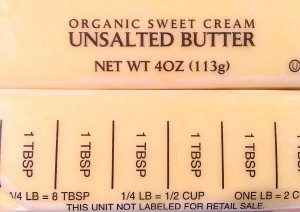 I started preparing the ingredients for a cake and I noticed the recipe called for unsalted butter. I knew butter came salted and unsalted, but I didn’t know if using salted butter would affect the outcome of the cake.
I started preparing the ingredients for a cake and I noticed the recipe called for unsalted butter. I knew butter came salted and unsalted, but I didn’t know if using salted butter would affect the outcome of the cake.
After a few hours of research, I discovered most chefs seem to think it is an issue of control. The amount of salt in different brands of salted butter can range from 1/4 teaspoon of salt per stick to 1/2 teaspoon of salt per stick. The more you control the variables in your food preparation, the more consistent your results will be.
That is good enough for me to continue using unsalted butter.
Lessons learned:
– There are three types of butter: cultured, sweet cream and raw.
– Cultured butter is made from a fermented cream.
– Sweet cream butter is made from pasteurized fresh cream.
– Raw cream butter is made from fresh or cultured unpasteurized cream.
– All categories of butter are sold in both salted and unsalted forms.
– Cultured butter is sometimes labeled “European-style” butter in the United States.
– Normal butter softens to a spreadable consistency around 60 °F.
– Clarified butter is butter with almost all of its water and milk solids removed, leaving almost-pure butterfat.
– Ghee is clarified butter which is brought to higher temperatures of around 250 °F once the water has cooked off, allowing the milk solids to brown.
– Once butter is softened, spices, herbs or other flavoring agents can be mixed into it, producing what is called a compound butter or composite butter.
– Here are the smoking points for common cooking fats.
Soybean oil – 495 °F
Sunflower oil – 437 °F
Corn oil – 446 °F
Peanut oil – 437 °F
Canola oil – 401 °F
Suet – 400°F
Olive oil – 374 °F
Lard – 374 °F
Vegetable shortening – 329 °F
Butter – 302 °F
